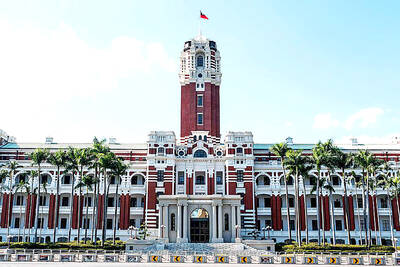Jordan is vying to break Israel’s dominance of a major cosmetics industry based on Dead Sea minerals famous for their therapeutic qualities but, despite an abundance of mud, still has far to go.
Two decades after production first started, the industry on the Jordanian side still has a turnover of just US$30 million a year and accounts for only 0.5 percent of the kingdom’s annual exports of about US$6 billion.
Israel’s Ahava, which markets its moisturizing lotions and a range of other Dead Sea products in 30 countries, alone earns more than US$150 million a year, five times more than all of the Jordanian companies.
Some 50 Jordanian firms produce Dead Sea cosmetics, but only 15 have a global presence in markets across the Middle East, Asia, Europe and the US.
“The kingdom is rich in materials and its Dead Sea shoreline is muddy, in contrast to Israel’s rocky shoreline,” said Osama Qutaishat, head of Jordan’s association of manufacturers of Dead Sea products and owner of one of its largest cosmetics companies.
Israel’s rocky shoreline has meant it has even imported raw materials from Jordan since the two countries signed a peace treaty in 1994.
“Many studies have shown that Dead Sea minerals including potassium, magnesium, silicon, sodium and calcium are effective in treating and preventing illnesses like psoriasis, eczema and acne,” Qutaishat said.
Landlocked between Jordan, Israel and the occupied West Bank, the Dead Sea is the world’s lowest and saltiest body of water.
Legend says the Queen of Sheba believed in its healing powers, and Egypt’s Cleopatra built a spa on its shores.
Lack of cooperation and the small size of the companies in the sector are the major problems of the industry, said Yarub Qudah, head of the state-owned Jordan Enterprise Development Corp.
“Their capabilities are limited. One of the solutions is systemized cooperation between the companies and the establishment of a consortium for exports,” he said.
“If the companies work properly, exports could reach 100 to 120 million dollars annually in five years,” he said, adding that if a plan to transform Dead Sea products into clinical products bears fruit, prices could jump “four or five times.”
Poor quality output by some firms has also been to blame, giving Jordanian products a bad name, the owners of some of the largest companies said.
Both Israel and Jordan are exploiting the Dead Sea tourist trade, with luxury hotels on either shore.
Both have also set up massive evaporation pools that harvest Dead Sea minerals like potash, or potassium carbonate, used to produce soap, glass, baking soda and fertilizers.
The Dead Sea, however, so named because virtually no life can tolerate its heavily salty waters, may be facing another kind of death — the sea’s surface level is plunging by a meter a year.
For centuries, the sea’s delicate balance was maintained by the Jordan river, its only year-round water source, but in recent decades Israel and Jordan have been diverting its waters into large irrigation projects.
The Dead Sea shoreline has receded by more than a kilometer in some places and the world-famous body of water could dry out completely by 2050, some calculations show.

The CIA has a message for Chinese government officials worried about their place in Chinese President Xi Jinping’s (習近平) government: Come work with us. The agency released two Mandarin-language videos on social media on Thursday inviting disgruntled officials to contact the CIA. The recruitment videos posted on YouTube and X racked up more than 5 million views combined in their first day. The outreach comes as CIA Director John Ratcliffe has vowed to boost the agency’s use of intelligence from human sources and its focus on China, which has recently targeted US officials with its own espionage operations. The videos are “aimed at

STEADFAST FRIEND: The bills encourage increased Taiwan-US engagement and address China’s distortion of UN Resolution 2758 to isolate Taiwan internationally The Presidential Office yesterday thanked the US House of Representatives for unanimously passing two Taiwan-related bills highlighting its solid support for Taiwan’s democracy and global participation, and for deepening bilateral relations. One of the bills, the Taiwan Assurance Implementation Act, requires the US Department of State to periodically review its guidelines for engagement with Taiwan, and report to the US Congress on the guidelines and plans to lift self-imposed limitations on US-Taiwan engagement. The other bill is the Taiwan International Solidarity Act, which clarifies that UN Resolution 2758 does not address the issue of the representation of Taiwan or its people in

US Indo-Pacific Commander Admiral Samuel Paparo on Friday expressed concern over the rate at which China is diversifying its military exercises, the Financial Times (FT) reported on Saturday. “The rates of change on the depth and breadth of their exercises is the one non-linear effect that I’ve seen in the last year that wakes me up at night or keeps me up at night,” Paparo was quoted by FT as saying while attending the annual Sedona Forum at the McCain Institute in Arizona. Paparo also expressed concern over the speed with which China was expanding its military. While the US

SHIFT: Taiwan’s better-than-expected first-quarter GDP and signs of weakness in the US have driven global capital back to emerging markets, the central bank head said The central bank yesterday blamed market speculation for the steep rise in the local currency, and urged exporters and financial institutions to stay calm and stop panic sell-offs to avoid hurting their own profitability. The nation’s top monetary policymaker said that it would step in, if necessary, to maintain order and stability in the foreign exchange market. The remarks came as the NT dollar yesterday closed up NT$0.919 to NT$30.145 against the US dollar in Taipei trading, after rising as high as NT$29.59 in intraday trading. The local currency has surged 5.85 percent against the greenback over the past two sessions, central